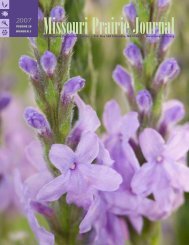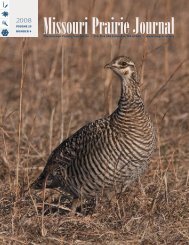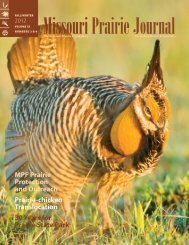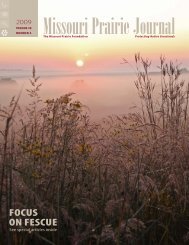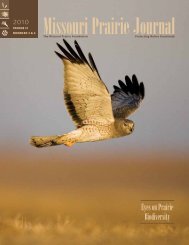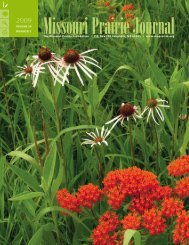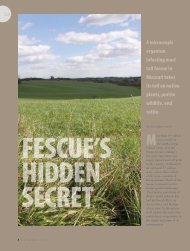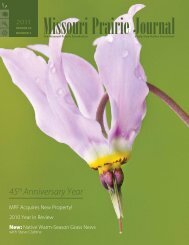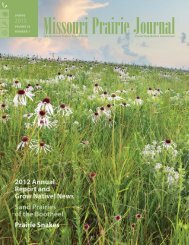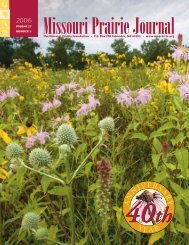Fall 2007: Volume 28, Number 4 - Missouri Prairie Foundation
Fall 2007: Volume 28, Number 4 - Missouri Prairie Foundation
Fall 2007: Volume 28, Number 4 - Missouri Prairie Foundation
Create successful ePaper yourself
Turn your PDF publications into a flip-book with our unique Google optimized e-Paper software.
community management and have some of thehighest quail densities in <strong>Missouri</strong>. Populationdensities on these areas frequently surpass onebird per two acres. Hi-Lonesome <strong>Prairie</strong> inBenton County is managed under a landscapescalenatural community approach that includespatch-burn grazing, which results in documentedgood quail habitat. Quail populations are likewiseabundant in many state parks. Rock BridgeMemorial State Park in Boone County has quailpopulation densities approaching one bird peracre. The quail on these properties and others likethem are abundant because of excellent naturalcommunity management. Additionally, the quailpopulations on these lands serve as a source forthose properties surrounding them.So, back to the original question: does itreally make sense to call quail an “edge” species?The answer to this question is complex andprobably is a matter of scale. Early explorers in<strong>Missouri</strong> described an abundance of quail longbefore mechanized agriculture found its wayto <strong>Missouri</strong>. Quail were subsequently pushedto margins of fields, as that is where the onlysuitable habitat remained, and concurrentlydeemed “edge” species. Modern agriculture hasall but removed these marginal habitats. Newprograms described in the Farm Bill will ensurethat many of these field edges are restored tosuitable quail habitat. However, if growingan agricultural crop is not your primary landmanagement objective and you want to produceas many quail as the land is capable, then look nofurther than maximizing the amount of usablespace available to quail by incorporating naturalcommunity management.Robert N. Chapman is a wildlifemanagement biologist with the <strong>Missouri</strong>Department of Conservation in Rolla.His professional interests include researchingthe response of plant communities andwildlife populations to fire.ReferencesThe quail illustrations byMark Raithel in this articleare used courtesy of the<strong>Missouri</strong> Departmentof Conservation, andwere created for theDepartment’s newlyrevised “Your Key to QuailHabitat 2008,” a free wallcalendar designed to helplandowners meet theirwildlife managementgoals. For nearly every dayof the year, the calendarnotes key events in thelife history of quail andother grassland birds,including prairie-chickens,bobolinks and scissortailedflycatchers. It alsoprovides reminders aboutthe best times to performmanagement activities,such as prescribed burningand light disking. Toreceive a copy of thecalendar, call your nearest<strong>Missouri</strong> Department ofConservation office andask to speak to a privateland conservationist.Guthery, F. S. 1997. A philosophy of habitat management for northern bobwhites.Journal of Wildlife Management 61(2): 291–301.Hiller, T. L., F. S. Guthery, A. R. Rybak, S. D. Fuhlendorf, S. G. Smith, W. H. Puckett,Jr. and R. A. Baker. <strong>2007</strong>. Management Implication of Cover Selection Data:Northern Bobwhite Example. Journal of Wildlife Management 71(1): 195–201.Johnson, J. 2006. MPF Celebrates 40 Years “Our Way.” <strong>Missouri</strong> <strong>Prairie</strong> Journal.27(4): 18–21.Kopp, S. D., F. S. Guthery, N. D. Forrester and W. E. Cohen. 1998. Habitatselection modeling for northern bobwhites on subtropical rangeland. Journal ofWildlife Management 62(3): 884–902.Leopold, A. 1933. Game Management. Charles Scribner’s Sons.Nelson, P. W. 1985. The Terrestrial Natural Communities of <strong>Missouri</strong>.<strong>Missouri</strong> Natural Areas Committee. 550 pp.Sauer, J. R., J. E. Hines, and J. <strong>Fall</strong>on. <strong>2007</strong>. The North American Breeding Bird Survey,Results and Analysis 1966 - 2006. Version 7.23.<strong>2007</strong>. USGS Patuxent WIldlifeResearch Center, Laurel, MD.19





